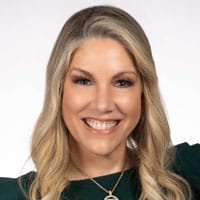I began using traditional media when I first started my practice in 2002. Initially, I was quoted in newspapers and magazines. Then I branched out into TV and radio. I did more TV than radio. Now social media is also helping me grow my brand and grow professionally.

I started using social media — a topic I now receive many inquiries about — during the financial crisis of 2008-2009. Back then, I joined Facebook to help me connect with old friends and, frankly, to relieve stress. I didn’t really use it for work initially, but if I was quoted in a publication or was on TV, I posted and shared it on Facebook.
I went on LinkedIn in 2010, back when it was more of a job-hunting site, and now have nearly 10,500 followers there. I joined Twitter in 2014 right before my book was released in 2015 because my agent said to get on it.
It took me longer to get on to Instagram because I am a Gen Xer and I thought it was for millennials or younger. So, I didn’t go on until 2019 and didn’t really get active until this year. I joined TikTok this year.
The power of connecting
Being on social media gives me a way to tell the world who I am, what I do and what I stand for. I also want my wide social circle to know what I’m up to. But I’ve found that having a presence on social media doesn’t mean that people come directly to find me on these platforms. So, I’ve been very consistent about posting regularly to generate interest.
Throughout my career, I’ve been the first person my clients call when they retire or have a sudden-money event or other milestone. Now, with social media, I often learn more about them because they’re apt to share more things sooner. You can participate in your clients’ lives in real-time and not have to wait until you have an in-person meeting.
I’ve also learned that going silent on social media and traditional media for four years — as I was forced to do at my former financial institution, Goldman Sachs, and then during a non-compete period after I left — hurts your visibility and momentum.
Once I went off social media and traditional media, I was out of sight, out of mind. I lost my influence and couldn’t be a thought leader. I lost my pipeline of new potential clients. My book sales dropped. I stopped getting asked to speak at industry events and to Fortune 500 companies, which had also fueled growth. Further, I lost the ability to connect with clients and colleagues on social media, which for me was very isolating.
I also lost my top ranking in the Investopedia Top 100 Advisors. In 2019 I was in the top 10. By the end of my social-media hiatus, I was completely off the list. Since I’ve rejoined social media, I am back on the list but not in the Top 10.
Understanding media
Media spans a gamut of channels, from print (newspapers, magazines) and broadcast (television, radio), to more contemporary digital platforms (websites, podcasts, social media). The role of media is pivotal: It molds public perspectives, disseminates news, facilitates knowledge sharing, and even shapes cultural trajectories. It can also be a very powerful tool for financial advisors.
Digital media is the format that is accessible to most advisors. If you don’t have contacts in traditional media or a big budget, it can be very difficult and time-consuming to make a lot of headway. Not to say that digital media doesn’t take time and money — it does — but an advisor can start some experimentation without a huge investment. Hiring a marketing firm that specializes in digital media may also be worth the money after you determine what you want to accomplish by using it.
As an advisor, you can use media to build a bridge to your clients and potential clients.
For example, I use social media to get new clients and to stay in front of existing clients. Since I am a connector by nature, this medium feels natural to me.
Social media is also a two-way street for me. First, by being connected with my current clients, I know what trips they took, if there’s a wedding or new child in the family, and if someone is unexpectedly hospitalized. My clients also know everything that is going on in my life because they see it on social media. It is fantastic to be part of each other’s lives more than just during meetings once or twice a year.
More digital outreach
In addition to social media, I also use other forms of digital media including my website, carycarbonaro.com. Through the first two-thirds of this year, I’ve already received about 30 real leads through the “contact me” button on my website and converted five of them into new clients. I offer those who reach out a complimentary consultation. (To learn how I charge clients, visit here.)
I have been a guest on podcasts but have not produced my own yet. It is mainly because I am just getting back and am rebuilding my media presence. But to my knowledge, I have never gotten a new client from a podcast.
Refinding my niche
Brokers-dealers, which are regulated by Finra, more strictly limit the use of social media and traditional media due to compliance reasons. RIAs, which fall under SEC rules, tend to offer more freedom to communicate and use the medium.
One of the many reasons I joined Advisors Capital Management a year ago was that it does not have the limitations that my former firm, Goldman Sachs, placed on advisors’ use of social media and anything related to speaking, writing, and communicating. At Goldman, we were barred from engaging with social media — no posting, sharing or even commenting. It felt akin to receiving calls without the freedom to respond. I ended up at Goldman after it bought my former RIA firm, United Capital, in 2019.
At United Capital, advisors like myself were permitted to use social media and it was an effective tool to communicate with clients. But Goldman Sachs only allowed social-media automation. When firms do this, they post for the advisors and everyone posts the same thing at the same time. There are no opinions, no personalization. In my opinion, Goldman’s inability to adapt led to its recently announced plans to sell United Capital.
Who’s your audience?
Leveraging social media can yield noteworthy benefits, but which platform works best often depends on your clients’ ages and other demographics. For example, nearly 80% of millennials and Gen Z have sought financial advice via social media, and 50% reported financial gains based on such advice. But older clients can also be influenced by social media.
According to a recent study of wealthy investors conducted by fintech firm Advisor360°, half of all respondents said they’d be more likely to engage an advisor who uses YouTube, slightly trailed by Facebook and LinkedIn. (Women prefer Facebook and men prefer Linkedin, the study also found). Even 36% of older GenX and younger boomers responded that they’d be more likely to engage an advisor who uses TikTok — the same percentage as older millennials and younger Gen Xers. But only Gen Z and younger millennials really view Instagram as an advisor advantage, according to the study.
Tapping into social media to elevate your profile
I now check my social media at least three times a day — morning, midday and end of day.
Here is my outlook on the best use of the various platforms and how I use them:
I believe it is a great platform for sharing content related to thought leadership in your industry. I am also connected there with clients who still work. I have never used LinkedIn for prospecting, but I do connect with people prior to scheduled meetings with them. My least favorite thing is when a stranger connects with me and then the next second sends me a pitch email. It is a waste of time and I always hit delete.
I share pictures, videos, articles and blogs on LinkedIn. I also support colleges by sharing their successes, books, media, etc. We can leverage each other’s networks. What is great is you can even see how much reach you have if you view the analytics.
It’s sometimes tricky if you keep your personal and business as one account, as I do. But I post both of my lives together here because I am the same outside and inside of my business.
On Facebook, my static pictures seem to do better than “reels” or videos or stories. I really enjoy learning about the lives of friends, family and clients. All my clients become friends — and some are my friends before they become my clients — so the client/friend line is blurred. My TV posts usually get the most interaction. Pictures I post of me and my husband doing something fabulous are popular too!
This platform used to include only pictures but it has expanded to include video reels as well. Since Instagram and Facebook are the same company now, if you post on one you can set it up to automatically post on the other.
Twitter (now known as X)
This is obviously used for shorter posts. I did fantastic on Twitter before my hiatus — I have approximately 8,500 followers, a figure which has not moved in years. I even got into some top rankings for women in finance. But ever since Elon Musk bought Twitter, changed its name and messed with the blue checks for verification, I have no idea what is going on now.
I am still on the platform but I have so little engagement now. When I post, no one sees or comments on my posts. Maybe Twitter’s algorithms have changed or maybe I just lost anyone who was interested in hearing from me.
TikTok
I’m still new here, so I haven’t yet haven’t figured out how the platform or its algorithm works. I just want to talk about money and see stories about money. Instead, every time I visit TikTok I get 5-year-olds singing badly and teenagers doing pranks. I have to turn the sound off because it drives me crazy.
My first TikTok posts were professional videos, but apparently, this is not what others post. In one video, I introduced myself and who I am as a CFP, etc. I got lots of negative feedback. It seems no one cares what your education or profession is. Then I did a video in which I spoke about my favorite chart, the Callan chart, and received more negative feedback. Strangers and some people I know said I talked over everyone’s head and I wasn’t natural on camera. Ugh, I was so frustrated.
And it got worse: After posting a video in which I spoke about the gender pay-wage gap, women trolled me saying, “There is no pay-wage gap, it’s a myth; you have no credibility,” etc. By the way, this post appeared on Yahoo Finance with the charts and graphs. I can share more thoughts about TikTok after I figure out what is going on. I do know that most viewers are much younger than me and my clients!
Verification
Ever notice the blue check marks next to your name (or someone else’s name) on the various platforms? That means you’ve been verified as the “real you.” Why is this important? I will share my cautionary tale with you: My Instagram account was cloned, which is what happens when someone pretends to be you and uses your credibility to do something nefarious.
In my case, someone reached out in my name to people through direct message (DM) and asked them about their money and trading strategies. They also tried to get them interested in cryptocurrency. Anyone who knows me knows that I would not do any of this, ever. In fact, many people reached out to me and said, “I think somebody cloned you.”
I repeatedly reached out to Instagram with no luck. Every time they shut down the account, the cloner(s) reopened it with one spelling change; this went on for a very long time. I had to hire an attorney who deals specifically with this issue and pay thousands of dollars out of my pocket for them to contact Instagram’s legal department. Finally, it stopped. For me, it is 100% worth it to protect your name and credibility. I haven’t shut down my Instagram account because it is an important social media platform and now I am verified.
YouTube
I have a page where I’ve started adding my videos, to house them. I also link to it for my website. I have no idea what I eventually plan to do with YouTube, but I think it could be an important tool for my practice.
The end game
My stance is to teach clients to “get rich slowly” by taking a more prudent approach to investing. However, what gets likes and clicks on social and digital media is sexy, get-rich-quick schemes. Those of us who teach sound money principles can’t compete, but I will not give up!
As I re-enter this realm after a four-year hiatus from social media, my mission is to learn and share knowledge. I don’t have all the answers, but I am interested in learning, sharing and growing! There are many advisors better than me. I would say I am good for a Gen Xer.
Remember, media and social media are formidable tools for branding and professional advancement when harnessed strategically. And feel free to connect with me on LinkedIn, Facebook, Instagram, Twitter, TikTok, and YouTube (though I’ve yet to widely promote my YouTube presence), or visit carycarbonaro.com. I look forward to connecting!
Cary Carbonaro, CFP, MBA, is SVP, director of Women & Wealth at ACM Wealth, the wealth planning team of Advisors Capital Management. She was appointed and has served as a CFP Board ambassador since 2014. Cary is the author of “The Money Queen’s Guide: For Women Who Want Build Wealth and Banish Fear.” She has spoken all over the world about financial literacy for women. You can reach her at cary.carbonaro@advisorscenter.com.







